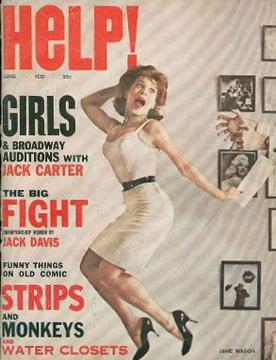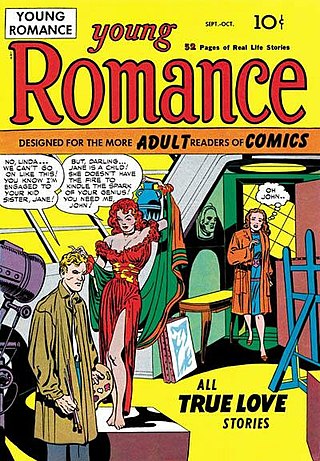
Mad is an American humor magazine first published in 1952. It was founded by editor Harvey Kurtzman and publisher William Gaines, launched as a comic book series before it became a magazine. It was widely imitated and influential, affecting satirical media, as well as the cultural landscape of the 20th century, with editor Al Feldstein increasing readership to more than two million during its 1973–1974 circulation peak.

Sergio Aragonés Domenech is a Spanish/Mexican cartoonist and writer best known for his contributions to Mad magazine and creating the comic book Groo the Wanderer.

Joseph Henry Simon was an American comic book writer, artist, editor, and publisher. Simon created or co-created many important characters in the 1930s–1940s Golden Age of Comic Books and served as the first editor of Timely Comics, the company that would evolve into Marvel Comics.

Timely Comics is the common name for the group of corporations that was the earliest comic book arm of American publisher Martin Goodman, and the entity that would evolve by the 1960s to become Marvel Comics.

Crazy Magazine is an illustrated satire and humor magazine that was published by Marvel Comics from 1973 to 1983 for a total of 94 regular issues. It was preceded by two standard-format comic books titled Crazy. The magazine's format followed in the tradition of Mad, Sick, Cracked and National Lampoon.

Cracked was an American humor magazine. Founded in 1958, Cracked proved to be the most durable of the many publications to be launched in the wake of Mad magazine.

Harvey Kurtzman was an American cartoonist and editor. His best-known work includes writing and editing the parodic comic book Mad from 1952 until 1956, and writing the Little Annie Fanny strips in Playboy from 1962 until 1988. His work is noted for its satire and parody of popular culture, social critique, and attention to detail. Kurtzman's working method has been likened to that of an auteur, and he expected those who illustrated his stories to follow his layouts strictly.

John Burton Davis Jr. was an American cartoonist and illustrator, known for his advertising art, magazine covers, film posters, record album art, and numerous comic book stories. He was one of the founding cartoonists for Mad in 1952. His cartoon characters are characterized by extremely distorted anatomy, including big heads, skinny legs, and large feet.

Help! was an American satire magazine that was published by James Warren from 1960 to 1965. It was Harvey Kurtzman's longest-running magazine project after leaving Mad and EC Publications, and during its five years of operation it was chronically underfunded, yet innovative.

Humbug is a humor magazine published from 1957 to 1958. Edited by Harvey Kurtzman, the magazine took satirical jabs at movies, television, advertising and various artifacts of popular culture, from cereal boxes to fashion photographs. Nine of the eleven issues were published in a black-and-white comic book-sized format.

Crestwood Publications, also known as Feature Publications, was a magazine publisher that also published comic books from the 1940s through the 1960s. Its title Prize Comics contained what is considered the first ongoing horror comic-book feature, Dick Briefer's "Frankenstein". Crestwood is best known for its Prize Group imprint, published in the late 1940s to mid-1950s through packagers Joe Simon and Jack Kirby, who created such historically prominent titles as the horror comic Black Magic, the creator-owned superhero satire Fighting American, and the first romance comic title, Young Romance.

Magazine Enterprises was an American comic book company lasting from 1943 to 1958, which published primarily Western, humor, crime, adventure, and children's comics, with virtually no superheroes. It was founded by Vin Sullivan, an editor at Columbia Comics and before that the editor at National Allied Publications, the future DC Comics.
Pyton was a Norwegian comic book series which was produced by the company Gevion, and afterwards Bladkompaniet, between the years 1986 until 1996. An anthology magazine with no major main character, its style of humor focused mostly on satiric and toilet humour, including sexual, toilet, and farting jokes. Most of Pyton's material was produced by the magazine's own staff, but a handful of foreign comics also appeared in the magazine, including Gary Larson's The Far Side, and the German comic Werner.
William Carl Schelly was an Eisner Award-winning author who chronicled the history of comic books and comic book fandom, and wrote biographies of comic book creators, including Otto Binder, L.B. Cole, Joe Kubert, Harvey Kurtzman, John Stanley, and James Warren as well as silent film comedian Harry Langdon.
Sick comedy was a term originally used by mainstream news weeklies Time and Life to distinguish a style of comedy/satire that was becoming popular in the United States in the late 1950s. Mainstream comic taste in the United States had favored more innocuous forms, such as the topical but inoffensive one-liners in Bob Hope's routines. In contrast, the new comedy favored observational monologues, often with elements of cynicism, social criticism and political satire.

Young Romance is a romantic comic book series created by Joe Simon and Jack Kirby for the Crestwood Publications imprint Prize Comics in 1947. Generally considered the first romance comic, the series ran for 124 consecutive issues under Prize imprint, and a further 84 published by DC Comics after Crestwood stopped producing comics.
Debuting in August 1952, Mad began as a comic book, part of the EC line published from offices on Lafayette Street in Lower Manhattan. In 1961 Mad moved its offices to mid-town Manhattan, and from 1996 onwards it was located at 1700 Broadway until 2018 when it moved to Los Angeles, California to coincide with a new editor and a reboot to issue #1.
Archie's Mad House was a comic book magazine published by Archie Comics from 1959 to 1982. The series went through a number of overhauls and name changes. Classic stories have occasionally appeared in digest magazines.

American cartoonist Harvey Kurtzman was the founding editor and primary writer for the humor periodical Mad from its founding in 1952 until its 28th issue in 1956. Featuring pop-culture parodies and social satire, what began as a color comic book became a black-and-white magazine with its 24th issue.

Alfred E. Neuman is the fictitious mascot and cover boy of the American humor magazine Mad. The character's distinct smiling face, parted red hair, gap-toothed smile, freckles, protruding ears, and scrawny body dates back to late 19th-century advertisements for painless dentistry, also the origin of his "What, me worry?" motto. The magazine's founder and original editor, Harvey Kurtzman, began using the character in 1954. He was named "Alfred E. Neuman" by Mad's second editor Al Feldstein in 1956. Neuman's likeness has appeared on all but a handful of the magazine's covers, over 550 issues. He has almost always been portrayed in front view, silhouette, or directly from behind.














